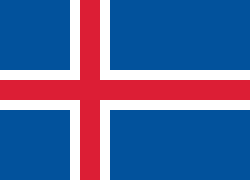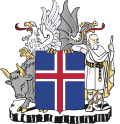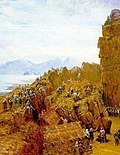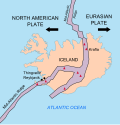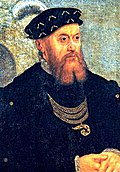Portal:Iceland
The Iceland Portal
Iceland is a Nordic island country between the Arctic Ocean and the North Atlantic Ocean, located on the Mid-Atlantic Ridge between Europe and North America. It is culturally and politically linked with Europe and is the region's westernmost and most sparsely populated country. Its capital and largest city is Reykjavík, which is home to about 36% of the country's roughly 390,000 residents (excluding nearby towns/suburbs, which are separate municipalities). The official language of the country is Icelandic. Iceland is on a rift between tectonic plates, and its geologic activity includes geysers and frequent volcanic eruptions. The interior consists of a volcanic plateau with sand and lava fields, mountains and glaciers, and many glacial rivers flow to the sea through the lowlands. Iceland is warmed by the Gulf Stream and has a temperate climate, despite being at a latitude just south of the Arctic Circle. Its latitude and marine influence keep summers chilly, and most of its islands have a polar climate. According to the ancient manuscript Landnámabók, the settlement of Iceland began in 874 AD, when the Norwegian chieftain Ingólfr Arnarson became the island's first permanent settler. In the following centuries, Norwegians, and to a lesser extent other Scandinavians, immigrated to Iceland, bringing with them thralls (i.e., slaves or serfs) of Gaelic origin. The island was governed as an independent commonwealth under the native parliament, the Althing, one of the world's oldest functioning legislative assemblies. After a period of civil strife, Iceland acceded to Norwegian rule in the 13th century. In 1397, Iceland followed Norway's integration into the Kalmar Union along with the kingdoms of Denmark and Sweden, coming under de facto Danish rule upon its dissolution in 1523. The Danish kingdom introduced Lutheranism by force in 1550, and the Treaty of Kiel formally ceded Iceland to Denmark in 1814. Influenced by ideals of nationalism after the French Revolution, Iceland's struggle for independence took form and culminated in the Danish–Icelandic Act of Union in 1918, with the establishment of the Kingdom of Iceland, sharing through a personal union the incumbent monarch of Denmark. During the occupation of Denmark in World War II, Iceland voted overwhelmingly to become a republic in 1944, ending the remaining formal ties to Denmark. Although the Althing was suspended from 1799 to 1845, Iceland nevertheless has a claim to sustaining one of the world's longest-running parliaments. Until the 20th century, Iceland relied largely on subsistence fishing and agriculture. Industrialization of the fisheries and Marshall Plan aid after World War II brought prosperity, and Iceland became one of the world's wealthiest and most developed nations. In 1950, Iceland joined the Council of Europe. In 1994 it became a part of the European Economic Area, further diversifying its economy into sectors such as finance, biotechnology, and manufacturing. (Full article...) Selected article -The Icelandic Naming Committee (Icelandic: Mannanafnanefnd; pronounced [ˈmanːaˌnapnaˌnɛmt])—also known in English as the Personal Names Committee—maintains an official register of approved Icelandic given names and governs the introduction of new given names into Icelandic culture. (Full article...) Selected picture Eyjafjallajökull is one of the smaller Icelandic glaciers, located north of Skógar and west of the larger glacier Mýrdalsjökull. The ice cap of the glacier covers a volcano, which has erupted relatively frequently since the Ice Age. The last eruption was from 1821 to 1823, causing a fatal glacier run. The crater of the volcano has a diameter of 3-4 km and the glacier covers an area of about 100 km². News
Main topicsSelected biography - Olaf the Peacock or Olaf Hoskuldsson (Old Norse: Óláfr "pái" Hǫskuldsson [ˈoːˌlɑːvz̠ ˈpʰɑːe ˈhɔˌskuldsˌson]; Modern Icelandic: Ólafur "pái" Höskuldsson [ˈouːˌlaːvʏr ˈpʰauːɪ ˈhœˌskʏl(t)sˌsɔːn]; c. 938–1006) was a merchant and chieftain of the early Icelandic Commonwealth, who was nicknamed "the Peacock" because of his proud bearing and magnificent wardrobe. He is a major character in the Laxdæla saga and is mentioned in a number of other Icelandic sources. The son of a slave woman, Olaf became one of the wealthiest landowners in Iceland and played a major role in its politics and society during the latter half of the tenth century. In addition to the Laxdæla Saga in which he takes a leading role, Olaf also is mentioned in Egils saga, Njáls saga, Gunnlaugs saga, Kormáks saga, Grettirs saga and the Landnámabók, among others. (Full article...) Did you know (auto-generated) -

Selected quoteGeneral imagesThe following are images from various Iceland-related articles on Wikipedia.
Things you can do
Wikipedia in Icelandic
Recognized content
New articlesThis list was generated from these rules. Questions and feedback are always welcome! The search is being run daily with the most recent ~14 days of results. Note: Some articles may not be relevant to this project.
Rules | Match log | Results page (for watching) | Last updated: 2025-08-07 20:58 (UTC) Note: The list display can now be customized by each user. See List display personalization for details.
Web resources
Associated WikimediaThe following Wikimedia Foundation sister projects provide more on this subject:
SourcesDiscover Wikipedia using portals | |||||||||||

